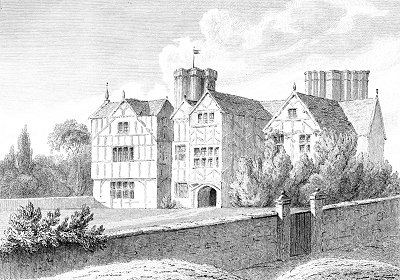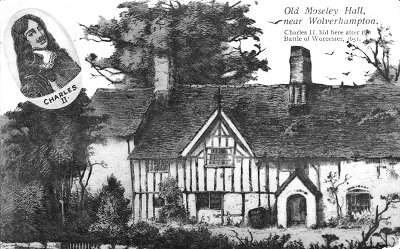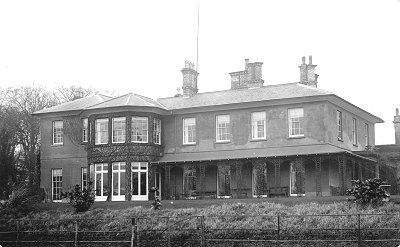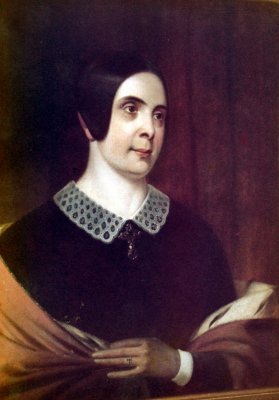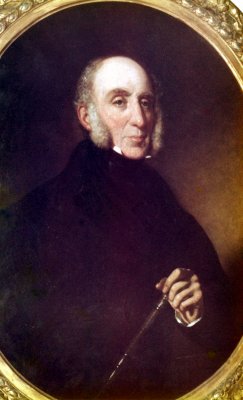|
THE WHITGREAVES OF MOSELEY AND ROMAN CATHOLICISM IN THE PARISHCatholicism in the parish During the second half of the sixteenth century in the years following the Reformation the West Midlands was one of several parts of England where many people, of all classes, clung to their Roman Catholic faith. In the area to the north of Wolverhampton, in the parishes of Brewood and Bushbury, the most prominent of these "recusants" (people who refused to worship in the parish churches) were the Giffards of Chillington and later the Whitgreaves of Moseley. Marriages were only recognised in law if they had been solemnised in an Anglican church, so it was usual for a Catholic ceremony to take place elsewhere either before or after the one in the parish church. Most Catholic children were baptised by a priest either at home or in one of the unlawful Catholic chapels such as the one on the first floor of the Whitgreave's house at Moseley. Burials were usually at the parish churches, or occasionally at the ruined Priory of Whiteladies, the service taking place in the evening. In the seventeenth century Catholics were fined (or compounded) for their persistent recusancy. The Whitgreave Family Of all the landowning families in Bushbury parish the Whitgreaves stayed longer than any other. From the end of the sixteenth century until the end of the nineteenth this Catholic family was an integral part of the community, respected by Protestant and Catholic alike. We know more about them than any other family for two reasons. Firstly because they were involved in events of national importance during the seventeenth century, (the escape of Charles II after the Battle of Worcester in 1651), their lives were recorded by national as well as local writers; and secondly, from about 1770 various members of the family kept diaries and day-books, many of which have survived. The Whitgreaves were not lords of the manor of Moseley. The family had been established at Burton near Stafford by 1300 and came to Moseley towards the end of the sixteenth century. Thomas Whitgreave of Bridgeford in Seighford (1526-90) married Dorothy Noel of Hilcote in Chebsey in 1559. They had five sons and two daughters: Edward born in 1560, Henry born in 1562, Humphrey born in 1564, Thomas born in 1568, Walter born in 1573, Lucretia and Bridget. Most of this generation appear to have been Protestant. Walter was an M.A. of Cambridge and vicar of Trumpington, Cambs.,1612-15; he died in 1616. Lucretia married the then lord of the manor of Moseley, William Moseley (of Moseley and Bilston) in the 1580s. He had been born in 1560 and was buried at Wolverhampton on June 9th 1610. It was the marriage of Lucretia's fourth brother, Thomas, to Alice Shaw (nee Pitt), a Catholic widow and heiress, which established the Catholic family at Moseley. The Whitgreaves at Burton near Stafford remained Protestant. In the Recusant Roll of 1607 Alice Whitgreave is listed but not her husband; he remained Protestant but had agreed that their children should be brought up in the Catholic faith. Also included in the Recusant Roll is Thomas's sister Lucretia Moseley but not her husband. Alice was one of the three daughters of Henry Pitt of Moseley, described as "Merchant of the Staple of England" in his will of October 17th 1602, and Joyce his wife. Alice's first husband, Thomas Shaw of Walsall, whom she married at Bushbury on October 29th 1601 had died in November 1603. Alice Shaw and Thomas Whitgreave were married in 1606 and lived in the house built by Henry Pitt about 1570 on the site of an earlier house which had apparently been destroyed by fire. The house is known today as Moseley Old Hall, to distinguish it from the manor house, Moseley Hall, a few hundred yards away, which was the seat of the Moseley family (later the Hortons) and was rebuilt in the early eighteenth century. Moseley Old Hall is a timber framed building, and since Henry Pitt was a Catholic who could afford his own chaplain, it contained a hiding place where a priest could be secreted if necessary.
Thomas and Alice had seven daughters and one son, Thomas, who was born (according to the pedigree which he signed) in 1625. On the other hand his monument in Bushbury church, erected in 1702 after his death, gives his age as eighty four. The year 1618 seems to be more likely for his birth as he was described as a lawyer in 1645, which would have been unlikely for a youth of twenty. Of the seven daughters, Joyce married Richard Paylin of Dearnsdale near Stafford; she died in 1686. Dorothy married John Spencer, a London merchant, and died in 1685. Alice was the third wife of William Reynolds of Cassington, Oxon.; she died in 1694. Margaret did not marry. Frances was married twice, first to Jerimiah Harrison M.D., and secondly to Captain Giles Brent of Maryland; she died in 1671. Elizabeth married Sampson Eardeswick of Hartly Green in Gayton, and Sarah married James Richardson of Stagsden in Bedfordshire. Thomas the elder died in January 1626, and in 1629 Alice his widow compounded for recusancy at the rate of £4 a year. Her sister-in-law Lucretia Moseley, also a widow, compounded for £8-17s-9d a year with £3 for arrears. In 1646 at the end of the Civil War Parliament sequestrated Alice's estates. Her son was by this time a captain in the Royalist army and had been wounded in the last battle of the war at Naseby in June 1645. The Escape of Charles II By 1651, when Charles II made his desperate attempt to regain his throne, which culminated in his defeat at the Battle of Worcester on September 3rd, Thomas Whitgreave was living at Moseley with his widowed mother but did not take any part in the battle as he was ill at the time. None of his sisters was living at home, but also in the house was Father John Huddleston, a Benedictine priest, and his three pupils - Francis Reynolds and Thomas Paylin, nephews of Thomas Whitgreave, and Sir John Preston, son of Sir John Preston of Preston of Thomas Morgan of Heyford Hall, Northants. John Huddleston had been chaplain to the boy's father. All of them became closely involved in Charles II's escape after the battle and the Whitgreaves and Moseley Old Hall played a central part in that dramatic and romantic story.
The Whitgreaves after the Civil War We know little of the events at Moseley during the Commonwealth. It seems unlikely that Thomas Whitgreave, as a Catholic, would have been permitted to practice as a lawyer, and when Staffordshire recusants were listed in 1657 only Alice was in the house. During this period a Thomas Whitgreave of Burton was Member of Parliament for the county from 1654-59 and was knighted by Cromwell in 1658. He was the great-grandson of Humphrey Whitgreave, the uncle of the first Thomas of Moseley. Thomas Whitgreave, father of Sir Thomas, was buried at St. Mary's Stafford on February 6th 1642/3. It was in 1666, six years after the Restoration of Charles II, that Thomas of Moseley was granted an annual pension of £200, and eleven years later this was ordered to be continued in his son's favour. Thomas was prosecuted for recusancy, but by Royal Order of 19th June 1675 proceedings were stopped. By Order of the Council on January 17th 1678/9 he was exempted from the punitive legislation following the Popish Plot. He later became a Gentleman Usher to Queen Catherine of Braganza. In 1669 Thomas married Constance, fifth daughter of Sampson Boughey of Colton near Rugeley and widow of Whitehall Degge. A son Thomas was born in 1672, and he was educated at Douai. A second son Robert died aged three. On February 27th 1695 Thomas the younger married at Edgbaston, Isobel Turville of Aston Flamville, Leics.. She inherited from her mother a considerable estate near Tamworth, which had belonged to her father Sir Aston Cockayne of Pooley Hall near Polesworth, Warws. Thomas the elder, known in the family as the "Protector", died on July 14th 1702 and was buried in Bushbury church. A tablet on the south wall of the nave commemorates his life. His wife lived until 1719 and was buried with him. The Whitgreaves in the 18th Century Thomas and Isobel had six sons and three daughters. Of these nine children, the two eldest, Thomas born February 8th 169617, and James Abel born March 3rd 1698, were educated at St. Omer and entered the Society of Jesus, Thomas on September 7th 1718, and James Abel on September 7th 1715. (Kirk's "Biographies" states that the third son John, entered the Society but appears to confuse him with Thomas.) James Abel served in the Maryland Mission from about 1724 until 1738 and then became a missioner in the College of Saint Chad in his native Staffordshire. He was its rector from 1743 to 1749 and died at Moseley in July 1750. Thomas was in Staffordshire from 1753 to 1757 and died on November 30th of that year. They were both buried at Bushbury. A daughter Frances was born to Thomas and Isobel on April 15th 1703 but lived only a few weeks. The next three sons, John, (born July 9th 1706, at school at Douai from October 1719), William (born 1709), and Charles (born August 6th 1711), all died young. John, who died in February 1725, and William who died in 1718, were both buried at Bushbury. Charles had been at school at Douai from August 1727, but after the death of his father on September 10th 1728 he returned home; he died on September 21st and was buried at St. Pancras, London. As a result the estate was inherited by the youngest son, Francis, who had been born on December 2nd 1716 and was therefore only eleven years of age at the time of his father's death. Of the two daughters of the marriage Mary Constance, (born 1707) married Joseph Kempson of Saredon in 1736 and died in 1751, and the younger Mary Isobel died unmarried in 1735. Their mother, Isobel lived until July 17th 1742 and was buried at Bushbury. The chapel at Moseley had been in use throughout the seventeenth century although the list of priests known to have served there dates from only 1724. Beside the family the chapel served the not inconsiderable Catholic community of the district. In 1705 and 1706 there were sixty four Catholics at Bushbury: as well as Thomas Whitgreave there were seven farmers, a shoemaker, a locksmith and four husbandmen or labourers with their families. By 1767 the number had increased to 116 including, beside the above occupations, a nailer and a bleacher of cloth. At the time of the 1715 Jacobite rising Thomas Whitgreave refused to sign his allegiance to George I and paid a fine of £127-15s for his Moseley estate and £42 for his Tamworth estate. With John Pidgeon he also paid £73-2s-6d as joint trustee for the estate of Nicholas Ryder at West Bromwich. After his death in 1728 his widow no doubt supervised the estate for her younger son Francis, supported by her Jesuit elder sons Thomas and James Abel after their return to Moseley. She died in 1742, but it was not until May 1754 that Francis married, his wife being Penelope, daughter of John Gelley of Wadsley Hall near Sheffield and his wife Penelope, daughter of William Jackson of Barton Blount and Roston, Derbys. A son was born on January 22nd 1755 and baptised Thomas Henry Francis, but his mother lived only until May of that year and was buried at Bushbury. Francis married again in April 1757, this time Ann, daughter of John Hassall of Astwood House in Claines near Worcester. Two sons were born, Francis on May 17th 1760, and John on July 17th 1761. This marriage was also short-lived as Ann died early in 1763 and was buried at Bushbury on January 27th. Francis was therefore left with three small sons. All his brothers and sisters were dead, and his nearest relative was his niece Mary Isobel Kempson, who had married Clement Paston of Worcester. It seems likely that young Thomas Henry Francis spent part of his childhood at the home of his maternal grandmother, Penelope Gelley, nee Jackson, of Barton Blount: in later life he was to erect a memorial tablet on the north wall of the chapel at Barton Hall, to the memory of Henry and Esther Jackson of that parish, who died there on August 1st 1763, aged 80, and November 27th 1754 aged 63, respectively. He refers to himself as their nephew but was probably a greatnephew. He inherited a considerable estate at Barton and Roston in Derbyshire from his grandmother. The Jackson charity of 1690, still commemorated in the vestry of the parish church at Norbury, Derbs., was paid in the nineteenth century by his son George Thomas in the parishes of Norbury, Marston Montgomery, and Barton Blount. By 1769 Thomas Henry Francis was at school at St. Omer. A letter to his father from the school has survived: "He is a good student, very judicious and prudent and very cheerful. If he ought to learn to dance or draw, be pleased to give order for it. He is very healthful, strong built, and well made. Desires his duty." The lives of the Whitgreaves in the 18th century From about this time our knowledge of the family becomes much more detailed, because Francis, his son Thomas Henry Francis, and other members recorded the events of their daily lives in a series of diaries and pocket books, many of which have survived. The first series by Francis Whitgreave covers the years 1771-1783. They include details of farm accounts, servants and their wages, land tax paid, payments for horse-breaking, and the sale and purchase of cattle. In August 1783 he employed 'Cheshire Reapers' to bring in his crops. Francis is shown to be a man of some culture, and his personal accounts include the purchase of books and musical instruments. He records the departure of his second son Francis to school at Douai, where he arrived on August 8th 1775. (The school records that he had been sent by Bishop Hornyold and that he stayed until April 1778.) In September of that year he was sent to Warrington as an apprentice. He never married and died on August 18th 1836. His brother John is not recorded as going abroad to school. His father's diary reports his departure to Worcester as a 'temporary apprentice' in July 1778. He married Teresa, daughter of Philip Hicken of Gornal in 1794, died in February 1799 and was buried at Bushbury. In his will he describes himself as a druggist. Their older half-brother, Thomas Henry Francis, starts his diary in 1773 with a list of books, sheet music and his linen. He was eighteen at the time and soon appears to have been managing the family estate at Saredon in the neighbouring parish of Shareshill. The priest at Moseley, Thomas Stone, seems to have been a constant companion and personal friend. On June 21st 1780 the diary records that 'Thomas Whitgreave married Mary Lockley at Saredon by Mr. Thomas Stone, the priest who lives with my father at Moseley', with the further entry on June 23rd, 'We went in a chair and four horses to Bushbury where we were married by Mr. Jones the curate who returned with us to dinner at Saredon'. His bride was the daughter of John Lockley of Beckbury, Salop, who had previously resided at Barton Park, Derbs. (In 1809 a John Lockley was living at Boscobel.) As the 1780s progress we follow the everyday events of his life: October 18th 1780 In the afternoon my wife, Mr. Lockley Senior and self walk down to Pratt's, after which she and I walked to the little school by the blacksmith's and back. April 5th 1781 This morning went down with Mr. Stone to the Deep Moors a-fishing. We caught 40 miniers. Returned to dinner. April 20th 1781 This morning Mr. Wells* (his wife's sister's husband), Mr. Stone and self walked to the Warren House upon Calf Heath to see the Roman Tumuli (which Mr. Plott mentions in his History of Staffordshire.) July 27th 1781 This morning I rode to Moseley and went a-fishing with Mr. Stone and my father. We caught two dozen and a half of perch in a little time and very pretty perch. August 27th 1781 This morning I rode round by Cannock and to Moseley, dined with Mr. Palmer at my Father's. In the afternoon Mr. Palmer drew a tooth for me.
The first child of the marriage, Henry Francis, was born on Friday, October 12th 1781, and was baptised at Moseley on the following Sunday. Thomas records the births and baptisms of each of his children in his Diary: John Joseph (born February 20th 1783), Penelope Mary (born July 28th 1784), Mary Ann (born June 5th 1785), George Thomas (born August 3rd 1787), Mary Ann (born January 18th 1789) and Isabella Ann (born April 15th 1790). The peaceful months and years go by, the simple pleasures of his life being entered in his diary day by day: November 8th 1781 `This morning my father came and I went with him and Mr. L. senior to Rodbaston where we bought 398 1/2 lbs store carp at 4d. per lb of Mr. Parsons, and Mr. Parsons sent them in a cart to Moseley. We returned to Saredon to dinner. Afternoon I rode with my father to Moseley to see him distribute the fish:into the large pool 50 brace Carp. The pool in Pit Leasow is no more, but the descendants of the fifty brace in 'the large pool' no doubt still swim in the mill pool on the south side of Moseley Hall. June 21st 1782 ....brought the big bay mare up to have her shod. Went to see her shod and called at Mr. Molyneux's at the school. July 13th 1782 This morning I and my wife walked to Betty Shotton's to see our little boy, took Harry Lockley with us and walked round by the New Lane and the blacksmith's and home to dinner. August 1st 1782 Walked ... to the Deep Moors and along the towing path up to the bridge, next the plow, tuned from there over Calf Heath and to the hedge course and home to dinner. Saw the proprietors of the canal go past in their boat in my walk this morning. December 27th 1783 At Moseley, My father, Harry and I went up to Mrs. Horton's*this morning and returned to dinner. December 29th 1783 At Moseley. My father, Bro. Frank, my wife and I dined, drank tea and supped at Mrs. Horton's today. The company consisted of Mr. and Mrs. Jesson, Mr. and Mrs. Wood, Mr.Carver and Miss Manley. In May 1785 Thomas records that his third child, Penelope Mary, 'had small pox very favourably' and in May 1790 his three sons were inoculated for small pox by Mr. Jones of Newport. But by the end of the 1780s the peace and contentment of his life were broken, first by the death of his father on September 12th 1789, and then by the loss of his wife Mary who died at Newport on April 29th 1790 after the birth of their daughter Isabella Ann on April 15th. She was buried at Bushbury on May 3rd. Thomas was left with a young family of three sons and two daughters. The two other daughters, both baptised Mary Ann, had died in infancy. The two elder boys were sent to the Catholic boys school at Sedgley Park, but tragedy struck again in June 1794 when they died of scarlet fever within a day of each other, John Joseph at Moseley and Henry Francis at Sedgley. The events of these grim years were lightened for Thomas only when, following the Relief Act of 1791, he was able to register 'a certain chapel at Moseley in the Parish of Bushbury' for Roman Catholics at the Translation Sessions of that year. Beside the diaries there also survive at the Staffordshire Record Office a few letters. One of them reminds us of the events of the outside world and the Napoleonic Wars so remote from the calm of Moseley. The Reverend John Carter, who spent the whole of his missionary life at Wolverhampton, writes to his friend Mr.Whitgreave in December 1798 suggesting all sorts of indignities he would like to inflict on Bonaparte. Carter was greatly respected in Wolverhampton and Bushbury and his death on March 31st 1803 is recorded in Bushbury Parish Register with a tribute from the vicar, John Clare. A fine stone marks his grave near the south wall of the nave of the parish church. Another note among these letters records the receipt at Moseley of the 'church goods' from the chapel at Horton in Gloucestershire on April 23rd 1795. This chapel had been opened by John Paston of Horton in 1708. His second son, Clement, had married Mary Isobel Kempson, grand-daughter of Thomas Whitgreave (1672-1728).The chapel had been closed in 1769 when the estate had been sold. Thomas Henry Francis continues his diary into the early years of the nineteenth century, planting fruit trees in 1796, buying silver in Birmingham in 1804, and restocking the ponds with carp in 1806. In 1812 he purchased a share in the Dunkirk Estate at Greet's Green in West Bromwich, an investment which no doubt proved its worth as the nineteenth century progressed and Black Country industry developed. He died at Moseley on January 19th 1816 and was buried at Bushbury by John Clare. The Whitgreaves in the 19th century His third but only surviving son, George Thomas, married on July 21st 1814 Amelia Ann, second daughter of B. Hodges of Millbank, Westminster, who settled the sum of £5000 at the time of the marriage. The ceremony in a Protestant church, still required by law, took place on the following day in the bride's parish of residence, Hanwell, Middlesex. The old Tudor house at Moseley was unsuitable for the London bride, and George Thomas bought land about half a mile away at Northeycote on the south side of Moseley Hall. His first child, Amelia Catherine Frances was born on May 16th 1815, and six days later he records 'I begin to sink the well and make the cellars for my new house 1815, and laid bricks June 17, alias Moseley Court.'
These nine consisted of four sons and five daughters: Amelia Catherine Frances, married John Butler Bowden on May 1st 1849 and died on November 24th 1874; Henry Benjamin George (born October 25th 1816) died August 13th 1881; Mary Constantia Josephine (born March 30th 1818) died August 2nd 1893; Francis (born September 27th 1819) died June 22nd 1896, Alfred Richard (born June 13th 1821) died May 25th 1837; Joseph Robert (born March 19th 1823) died February 3rd 1885; Maria Theresa (born November 1st 1824) married G.B.Eyston and died March 11th 1911; Julia Cecelia (born September 13th 1826) died August 6th 1910; Catherine Georgiana (born September 14th 1832) and died November 15th 1835. The two children who died young, Alfred Richard and Catherine Georgiana, were interred at the chapel. During the nineteenth century we see the descendants of the other branch of the Whitgreave family from Francis' second marriage to Ann Hassall of Worcester, not in the industrial and landowning class but rather in the ranks of the professional middle class. The marriage of their grandson John (1799-1867) to Ann Bagnall of Walsall illustrates this. Of their six children, Thomas was a solicitor in Walsall, Vincent a physician in Nottingham, (his son Charles Vincent also became a solicitor), and Teresa married a Professor McColl of Oxford.
In August they travelled home to Moseley on the new London and Birmingham Railway, spending two nights at Princethorpe, Warws. en route. This was presumably to visit the Benedictine nunnery then where one of their daughters lived. August 17th 1837 "We breakfasted early and at 8 in the morning we started from Eaton Square in our carriage to Euston Square. At half past 9 Mr. W. and I started by railway to Coventry, where we arrived at 5. Drank tea there and proceeded in car to Princethorpe Hotel." August 18th "...we walked out and dined at the Hotel. In the evening we went to the Convent, then went back to the hotel." August 19th (Sunday) "We went to 8 o'clock Mass and breakfasted at the Convent with Revd. Mr. Turner.... At 12 we started in a car to Coventry. At 3 went by railway to Birmingham where we dined, then again by railway to Wolverhampton, took a car to Moseley and arrived at half past eight."
In 1847 Francis, the second son of George Thomas and Amelia, was in the near East, and we have a record of his hiring camels for the journey from Cairo to Ramle near Alexandria. He married on September 18th 1853, Teresa, seventh daughter of Sir Edward Mostyn of Talacre, Flintshire. Amelia died on January 24th 1848. George Thomas, on October 10th 1849, wed Mary Juliana Charlotte, daughter of the Hon. Sir John Talbot G.C.B. She died in 1854, and in the next year he married for the third time. His bride was Mary Ann Sandford. He died in February 1863, at "Newbould House", Leamington, and his wife on December 27th 1886. Henrietta Maria, wife of Henry Benjamin George, died in February 1852 at Pau in the south of France, where she is buried. In 1858 he married again, his second wife being Mary Selby of Biddestone, Wilts. Their only child, Walter died in infancy. After the death of George Thomas in 1863, his son did not live at Moseley Court for long, although one of the last guests to be invited there was Archbishop Manning, when he visited Wolverhampton in 1865. By 1868 Moseley Court had been let to John Moreton a Wolverhampton businessman. In 1851 Francis, the second son of George Thomas, bought the moated site of the family's old house, Burton Manor near Stafford, which had been sold in 1720 on the death of Richard, last of the Burton Whitgreaves. A new house to the design of E. W. Pugin was completed in 1855, and still stands as the Social and Sports Club of the British Reinforced Concrete Company. When Henry Benjamin George died in 1881, his brother Francis of Burton Manor was the senior member of the family. Their brother Alfred had died in 1837, but the fourth brother Joseph Robert, following his marriage on January 18th 1853, in St. George's Cathedral Southwark, to Rosina Hodges, a cousin, was to make his home at Rugeley where he built a new house "Heron Lodge". With one of his sisters, (the Benedictine nun at Princethorpe), he built St. Joseph's Catholic church at Rugeley. He is buried in the churchyard with his wife and daughter. Francis' heir, Robert was educated at the Catholic College at Ushaw, a few miles from Durham, and in 1880 married Marion Leadbitter-Smith from nearby Floss Hall. They lived for a time at Moseley Court, but also built a new house "Bushbury Lodge" at Walton Park, Clevedon, Somerset. The Whitgreaves in the 20th century The story of their family is typical of so many English landowning families in the twentieth century. Of their three sons, Henry Edgerton, the eldest was commissioned in the Somerset Light Infantry and died on the Somme on July 1st 1916. He is buried in the No.1.Cemetery at Redan Ridge, Beaumont Hamel. There is a memorial to him at the Franciscan Friary, Marine Hill, Clevedon. His youngest brother Robert Francis had died in 1909. The third brother, John Lockley Joseph, following the death of his wife less than a year after their marriage, sold Moseley Court in 1922, so ending the family's long association with Bushbury. Their only sister, Miss Mildred Dorothy Mary, did not marry. She lived most of her life in Devon, but a few years before her death, about 1970, came to see the Old Hall. Moseley Court passed through several hands and was demolished in the 1960s, following the death of the owner Mr. A. J. Wesson. The Old Hall survives, secure if less attractive in a casing of Victorian red brick. After the family had left about 1821 it was used as a farm-house until 1962. In that year the Wiggin family, who had bought it in 1940, transferred it to the National Trust. The Trust's Wolverhampton Centre and the Staffordshire County Council, by appeal and grant, provided the endowment, and the Historic Buildings Commission assisted in its restoration; it was furnished in the style of the seventeenth century and was opened to the public in 1963. The new church of St. Mary's at Oldfallings was opened in September 1933 Priests at Moseley.
|

